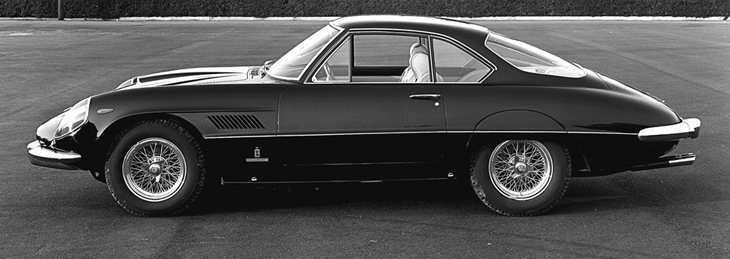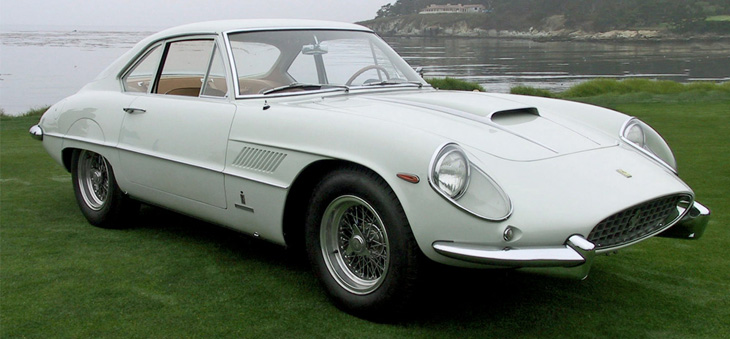|
They were constructed along the same general lines as those of the concurrent 250 GT series, with a pair of large section, oval longitudinal tubes passing over the rear axle and substantial cross bracing,
plus a built-up front cross-member. Similarly, the suspension was independent at the front, via wishbones with individual coil springs and shock absorbers, whilst the rigid rear axle was supported on semi-elliptic leaf springs,
and fitted with radius arms, whilst hydraulic shock absorbers were provided to each wheel. Hydraulically operated disc brakes were fitted all round, with a cable operated handbrake to the rear wheels. Apart from chassis 2311SA,
all were left-hand drive.
The engines, with factory type reference 163, had a compression ratio of 8.8:1, and were a departure from the 'long' block Lampredi-designed engines used in the preceding 410 series of cars.
Instead they had a 'short' block motor, based on the original Colombo SOHC per bank design used in the concurrently produced 250 GT series. This was stretched to increase the capacity, by enlarging the bore to 77 mm and
lengthening the stroke to 71 mm, providing a total capacity of 3967 cc. A twin coil and distributor ignition system was fitted, with the drive to the distributors from the rear of the camshafts on each bank of the vee. Triple
twin-choke Weber 40 DCZ/6, 42 DCN or sometimes Solex C40 PAAI carburettors were fitted, to provide a claimed power output of 340 bhp. The engine was coupled to a 4-speed, all synchromesh gearbox, fitted with an electronic
overdrive unit on top gear, driving through a universally jointed propeller shaft to a rigid rear axle.
The first example was a one-off, special-bodied car built for Fiat supremo Gianni Agnelli, on chassis 1517SA, in
late 1959 and presented at the Turin Salon that October. The design featured a large square radiator grille that extended almost to the bottom of the front valance, with quarter bumpers either side of it. There were also
current American styling elements: a horizontal twin headlight layout at the wing extremities with a single fog light below it, and a wrap-around windscreen. The tail light treatment was a vertical chrome bezel to each wing,
incorporating three circular lenses, which would subsequently see series production on the 400SA cabriolets, early coupés and the 250 GTE series which began in 1960. Between the Turin Salon and delivery to the client at the end
of May 1960, the design was refined. The frontal metalwork was modified to reduce the size of the radiator grille, which still remained square in shape, now with a full width bumper running below it. The horizontal inlets that
had originally featured above the quarter bumpers disappeared, the shape of the bonnet air intake was also altered, and a bright metal trim strip was added along the body side swage line to accentuate this feature.
The
second example, and the first of the true production series, was a cabriolet, chassis 1611SA, which made its public debut at the Brussels Salon in January 1960, then went on to be displayed at the New York Show a few weeks
later. The 400 SA Cabriolet was similar in overall shape to the 250 GT Cabriolet of the period, although it had a shallower grille opening, normally with uncovered fog lights in the grille extremities, and occasionally an
additional central driving light. As these were extremely expensive, limited production cars, individual clients could have them personalised. Thus, no two cars had exactly the same details. One of the clearer options was the
availability of open headlights or recessed units under Plexiglass covers. When the open light option was specified on a 'coupé aerodinamico', the whole frontal aspect of the car changed from the projecting oval radiator grille
shape, to that used on the cabriolets. One example, chassis 2311 SA, received a body virtually identical to the 250 GT California Spider, with right-hand drive, built specifically by Scaglietti for Ferrari board member, Michel
Paul-Cavallier. Another, chassis 3673SA, had a body in the style of the 250 GT 'passo corto' berlinetta. It has been erroneously reported that Enzo Ferrari used an example wearing a 250 GTE 2+2 body, but factory records confirm
that this was a normal 250 GTE, chassis 2257GT.
The 'coupé aerodinamica' for the 400 Superamerica coupé evolved from a design study shown by Pininfarina on their stand at the Turin Salon in November 1960. On a 400 SA,
chassis 2207SA, which bore the name 'Superfast II', it was used by Battista 'Pinin' Farina as his personal car, whilst it underwent a series of developments to its shape. It earned the epithet 'coupé aerodinamica' due to the
long and low flowing curved lines, which swept into the cabin, where the windscreen pillars curved both inward and rearward, and the shallow rear screen angle ran in a straight line through the boot to the tail at bumper level.
There the circular tail lights were in a horizontal protective shroud forming part of the wrap-around quarter bumpers. The initial rendering had retractable headlights in the nose panel and a shallow, oval egg-crate radiator
grille bounded by quarter bumpers with over-riders sweeping under the front apron. During the winter of 1960-61, the car received a wide shallow air intake on the bonnet with a fancy chrome surround trim; small circular parking
lights were semi-recessed in the tops of the front wings, the rear wheel arch spats disappeared, and quarter lights appeared in the door glass.
The second full iteration of the design on the same chassis was called
Superfast III; displayed at the Geneva Salon in March 1962, by this time it featured a revised cabin glass area with new slimmer C-pillars and larger rear quarter windows. At the front the nose profile was altered to provide a
very shallow, elliptical radiator intake with a thermostatically controlled, metal cover panel adorned with a 'Cavallino Rampante'. Other notable alterations were: a change of colour from white to metallic green (having also
been metallic grey in the interim), the reinstatement of spats to the rear wheel arches, whilst exhaust air outlets were provided on the lower rear wing panels. This car then underwent further metamorphosis to become the
Superfast IV, the most obvious innovation being the headlight treatment. Gone were the retractable units, to be replaced with uncovered paired headlights, 7" diameter outer and 5" diameter inner units, a theme that would be
used on the 330 GT in 1964. Not so noticeable was a slight change to the C-pillar design, and the raising of the lower edge of the rear screen.
Meanwhile the model had gone into series production, with the first customer
version being exhibited at the 1961 Geneva Salon. This had most of the design features of Superfast II, except that the headlights were more traditional units under Plexiglass covers recessed in the front wings. As previously
noted, there were individual differences to specific cars. Apart from the open or closed headlight option, there were alternative door handle assemblies (a conventional chrome-plated with push button, or a recessed lever type),
whilst some cars had rear wheel spats fitted but others did not. Those built until the middle of 1962 had the 2420 mm wheel base, while those built later had the 2600 mm wheel base. The latter cars can be identified by the
greater space between the trailing edge of the door and the forward edge of the rear wheel arch. They usually featured a closed bonnet blister too, instead of the earlier open intake with chrome surround trim. The total
production run was: one Scaglietti spider, one Scaglietti berlinetta, nine cabriolets and thirty-five coupés, in the chassis number range 1517SA to 5139SA. It should also be noted that the two 4-litre GTOs (chassis 3765 and
4561) plus the four 330 LM berlinettas (chassis 4381, 4453, 4619 and 4725), all had chassis numbers with an SA suffix from this series of cars.
Engine
- Type : front, longitudinal 60° V12
- Bore/stroke : 77 x 71 mm
- Unitary displacement : 330.62 cc
- Total displacement : 3967.44 cc
- Compression ratio : 8.8 : 1
- Maximum power : 250 kW (340 hp) at 7000 rpm
- Power per litre : 86 hp/l
- Valve actuation : single overhead camshaft per bank, two valves per cylinder
- Fuel feed : three Weber 46 DCF/3 carburettors
- Ignition : single spark plug per cylinder, two coils
- Lubrication : wet sump
- Clutch : single-plate
Chassis
- Frame : tubular steel
- Front suspension : independent, unequal-length wishbones, coil springs, telescopic shock absorbers, anti-roll bar
- Rear suspension : live axle, twin radius arms, semi-elliptic springs, co-axial springs and telescopic shock absorbers
- Brakes : discs
- Transmission : 4-speed + overdrive + reverse
- Steering : worm and sector
- Fuel tank : capacity 120 litres
- Front tyres : 6.50 x 15
- Rear tyres : 6.50 x 15
Bodywork
- Type : two-seater coupé, cabriolet
- Wheelbase : 2420 mm
- Front track : 1359 mm
- Rear track : 1350 mm
- Weight : 1250 kg (dry, coupé)
Performance



|